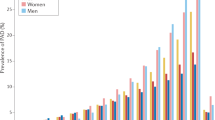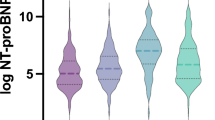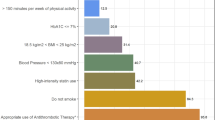Abstract
The increased risk of atherothrombotic events present in all patients with peripheral arterial disease (PAD) is amplified with concomitant diabetes. Moreover, diabetes is associated with increased PAD severity. This Review summarizes atherothrombosis and PAD in patients with diabetes, and American College of Cardiology and American Heart Association guidelines for management of patients with PAD. Patients with PAD and diabetes require optimal limb care and aggressive cardiovascular risk reduction. An LDL cholesterol level of less than 1.8 mmol/l (<70 mg/dl) is the therapeutic goal in these patients, and this target should be pursued using an aggressive statin regimen. Fibrate therapy can also be indicated. β-blockers and angiotensin-converting-enzyme inhibitors reduce cardiovascular events in high-risk patient populations, and these agents are recommended for use in patients with both diabetes and PAD. Blood pressure of less than 130/80 mmHg should be achieved, and glycated hemoglobin should be reduced to below 7%. Patients should also receive indefinite antiplatelet therapy with aspirin or clopidogrel. For patients with claudication, a supervised exercise program and cilostazol therapy to improve PAD symptoms and walking distance form the main noninvasive components of therapy. Revascularization can also be indicated in carefully selected patients with claudication. For patients with critical limb ischemia, diagnostic testing by a vascular specialist will determine whether revascularization or amputation is feasible.
Key Points
-
Peripheral arterial disease is associated with an increased risk of atherothrombotic events in other vascular beds owing to common pathophysiology
-
PAD is more prevalent and is associated with a worse prognosis in patients with diabetes mellitus than in nondiabetic patients, and patients with diabetes require more-intensive treatment to reduce cardiovascular risk, as diabetes is an independent risk factor for atherothrombotic events
-
PAD often goes undetected and untreated as only the minority of patients have classic claudication, and patients with diabetes can present later with more-severe disease secondary to neuropathy
-
Evidence-based guidelines for PAD published by the American College of Cardiology (ACC) and the American Heart Association (AHA) state that patients with PAD should receive treatment for cardiovascular risk reduction, including antiplatelet agents, lipid-lowering therapy and antihypertensives, in addition to smoking cessation therapy and improved glycemic control
-
The ACC/AHA guidelines also recommend exercise therapy and pharmacological therapy (primarily with cilostazol) to treat PAD symptoms, but patients who develop critical limb ischemia might require revascularization, and in the case of disease progression, amputation
This is a preview of subscription content, access via your institution
Access options
Subscribe to this journal
Receive 12 print issues and online access
$209.00 per year
only $17.42 per issue
Buy this article
- Purchase on Springer Link
- Instant access to full article PDF
Prices may be subject to local taxes which are calculated during checkout





Similar content being viewed by others
References
Hiatt WR (2001) Medical treatment of peripheral arterial disease and claudication. N Engl J Med 344: 1608–1621
Kannel WB (1994) Risk factors for atherosclerotic cardiovascular outcomes in different arterial territories. J Cardiovasc Risk 1: 333–339
American Diabetes Association (2003) Peripheral arterial disease in people with diabetes. Diabetes Care 26: 3333–3341
Hirsch AT et al. (2001) Peripheral arterial disease detection, awareness, and treatment in primary care. JAMA 286: 1317–1324
McAlpine RR et al. (2005) The annual incidence of diabetic complications in a population of patients with Type 1 and Type 2 diabetes. Diabet Med 22: 348–352
Weitz JI et al. (1996) Diagnosis and treatment of chronic arterial insufficiency of the lower extremities: a critical review. Circulation 94: 3026–3049
Khattab AD et al. (2005) Peripheral arterial disease in diabetic patients selected from a primary care setting: implications for nursing practice. J Vasc Nurs 23: 139–148
Hirsch AT et al. (2006) ACC/AHA 2005 guidelines for the management of patients with peripheral arterial disease (lower extremity, renal, mesenteric, and abdominal aortic): a collaborative report from the American Association for Vascular Surgery/Society for Vascular Surgery, Society for Cardiovascular Angiography and Interventions, Society for Vascular Medicine and Biology, Society of Interventional Radiology, and the ACC/AHA Task Force on Practice Guidelines (Writing Committee to Develop Guidelines for the Management of Patients With Peripheral Arterial Disease) endorsed by the American Association of Cardiovascular and Pulmonary Rehabilitation; National Heart, Lung, and Blood Institute; Society for Vascular Nursing; TransAtlantic Inter-Society Consensus; and Vascular Disease Foundation. Circulation 113: e463–654
Dormandy J et al. (1999) Predicting which patients will develop chronic critical leg ischemia. Semin Vasc Surg 12: 138–141
Jude EB et al. (2001) Peripheral arterial disease in diabetic and nondiabetic patients: a comparison of severity and outcome. Diabetes Care 24: 1433–1437
Centers for Disease Control and Prevention (2005) Mobility limitation among persons aged ≥40 years with and without diagnosed diabetes and lower extremity disease–United States, 1992–2002. Morb Mortal Wkly Rep 54: 1183–1186
Lowe GD et al. (1993) Blood viscosity, fibrinogen, and activation of coagulation and leukocytes in peripheral arterial disease and the normal population in the Edinburgh Artery Study. Circulation 87: 1915–1920
Eckel RH et al. (2002) Prevention Conference VI: Diabetes and Cardiovascular Disease: Writing Group II: pathogenesis of atherosclerosis in diabetes. Circulation 105: e138–143
Beckman JA et al. (2002) Diabetes and atherosclerosis: epidemiology, pathophysiology, and management. JAMA 287: 2570–2581
Stevens RJ et al.; United Kingdom Prospective Diabetes Study (UKPDS) Group (2001) The UKPDS risk engine: a model for the risk of coronary heart disease in type II diabetes (UKPDS 56). Clin Sci (Lond) 101: 671–679
Turner RC et al. (1998) Risk factors for coronary artery disease in non-insulin dependent diabetes mellitus: United Kingdom Prospective Diabetes Study (UKPDS: 23). BMJ 316: 823–828
Reaven PD et al. (2005) Coronary artery and abdominal aortic calcification are associated with cardiovascular disease in type 2 diabetes. Diabetologia 48: 379–385
Creager MA et al. (2003) Diabetes and vascular disease: pathophysiology, clinical consequences, and medical therapy: Part I. Circulation 108: 1527–1532
Huysmans K et al. (1998) Hypertension and accelerated atherosclerosis in endstage renal disease. J Nephrol 11: 185–195
Brownlee M (2001) Biochemistry and molecular cell biology of diabetic complications. Nature 414: 813–820
Cipollone F et al. (2003) The receptor RAGE as a progression factor amplifying arachidonate-dependent inflammatory and proteolytic response in human atherosclerotic plaques: role of glycemic control. Circulation 108: 1070–1077
Englyst NA et al. (2003) A novel role for CD36 in VLDL-enhanced platelet activation. Diabetes 52: 1248–1255
Nicholson AC et al. (2004) CD36, oxidized LDL and PPAR gamma: pathological interactions in macrophages and atherosclerosis. Vascul Pharmacol 41: 139–146
Wild SH et al. (2006) Low ankle-brachial pressure index predicts increased risk of cardiovascular disease independent of the metabolic syndrome and conventional cardiovascular risk factors in the Edinburgh Artery Study. Diabetes Care 29: 637–642
Aboyans V et al. (2006) Risk factors for progression of peripheral arterial disease in large and small vessels. Circulation 113: 2623–2629
Khan NA et al. (2006) Does the clinical examination predict lower extremity peripheral arterial disease? JAMA 295: 536–546
Mohler ER III et al. (2004) Utility and barriers to performance of the ankle-brachial index in primary care practice. Vasc Med 9: 253–260
Duvall WL et al. (2004) Multi-bed vascular disease and atherothrombosis: scope of the problem. J Thromb Thrombolysis 17: 51–61
Haffner SM et al. (1998) Mortality from coronary heart disease in subjects with type 2 diabetes and in nondiabetic subjects with and without prior myocardial infarction. N Engl J Med 339: 229–234
Ridker PM et al. (2004) Clinical usefulness of very high and very low levels of C-reactive protein across the full range of Framingham Risk Scores. Circulation 109: 1955–1959
Tzoulaki I et al. (2005) C-reactive protein, interleukin-6, and soluble adhesion molecules as predictors of progressive peripheral atherosclerosis in the general population: Edinburgh Artery Study. Circulation 112: 976–983
Wildman RP et al. (2005) Relation of inflammation to peripheral arterial disease in the national health and nutrition examination survey, 1999–2002. Am J Cardiol 96: 1579–1583
Conroy RM et al. (2003) Estimation of ten-year risk of fatal cardiovascular disease in Europe: the SCORE project. Eur Heart J 24: 987–1003
Law M et al. (1995) An analysis of the effectiveness of interventions intended to help people stop smoking. Arch Intern Med 155: 1933–1941
Jorenby DE et al. (1999) A controlled trial of sustained-release bupropion, a nicotine patch, or both for smoking cessation. N Engl J Med 340: 685–691
Jorenby DE et al. (2006) Efficacy of varenicline, an α4 β2 nicotinic acetylcholine receptor partial agonist, vs placebo or sustained-release bupropion for smoking cessation: a randomized controlled trial. JAMA 296: 56–63
Gonzales D et al. (2006) Varenicline, an α4 β2 nicotinic acetylcholine receptor partial agonist, vs sustained-release bupropion and placebo for smoking cessation: a randomized controlled trial. JAMA 296: 47–55
Tonstad S et al. (2006) Effect of maintenance therapy with varenicline on smoking cessation: a randomized controlled trial. JAMA 296: 64–71
Nathan DM et al. (2005) Intensive diabetes treatment and cardiovascular disease in patients with type 1 diabetes. N Engl J Med 353: 2643–2653
Stratton IM et al. (2000) Association of glycaemia with macrovascular and microvascular complications of type 2 diabetes (UKPDS 35): prospective observational study. BMJ 321: 405–412
UK Prospective Diabetes Study (UKPDS) Group (1998) Effect of intensive blood-glucose control with metformin on complications in overweight patients with type 2 diabetes (UKPDS 34). Lancet 352: 854–865
UK Prospective Diabetes Study (UKPDS) Group (1998) Intensive blood-glucose control with sulphonylureas or insulin compared with conventional treatment and risk of complications in patients with type 2 diabetes (UKPDS 33). Lancet 352: 837–853
Dormandy JA et al. (2005) Secondary prevention of macrovascular events in patients with type 2 diabetes in the PROactive Study (PROspective pioglitAzone Clinical Trial In macroVascular Events): a randomised controlled trial. Lancet 366: 1279–1289
Pyorala K et al. (1997) Cholesterol lowering with simvastatin improves prognosis of diabetic patients with coronary heart disease: a subgroup analysis of the Scandinavian Simvastatin Survival Study (4S). Diabetes Care 20: 614–620
Heart Protection Study Collaborative Group (2002) MRC/BHF Heart Protection Study of cholesterol lowering with simvastatin in 20,536 high-risk individuals: a randomised placebo-controlled trial. Lancet 360: 7–22
Collins R et al.; Heart Protection Study Collaborative Group (2003) MRC/BHF Heart Protection Study of cholesterol-lowering with simvastatin in 5963 people with diabetes: a randomised placebo-controlled trial. Lancet 361: 2005–2016
Mohler ER III et al. (2003) Cholesterol reduction with atorvastatin improves walking distance in patients with peripheral arterial disease. Circulation 108: 1481–1486
Haffner SM (2004) Dyslipidemia management in adults with diabetes. Diabetes Care 27 (Suppl 1): S68–S71
Graham DJ et al. (2004) Incidence of hospitalized rhabdomyolysis in patients treated with lipid-lowering drugs. JAMA 292: 2585–2590
Keech A et al. (2005) Effects of long-term fenofibrate therapy on cardiovascular events in 9795 people with type 2 diabetes mellitus (the FIELD study): randomised controlled trial. Lancet 366: 1849–1861
Meade T et al. (2002) Bezafibrate in men with lower extremity arterial disease: randomised controlled trial. BMJ 325: 1139–1144
UK Prospective Diabetes Study Group (1998) Tight blood pressure control and risk of macrovascular and microvascular complications in type 2 diabetes: UKPDS 38. BMJ 317: 703–713
Hennekens CH et al. (1996) Adjunctive drug therapy of acute myocardial infarction—evidence from clinical trials. N Engl J Med 335: 1660–1667
Yusuf S et al. (2000) Effects of an angiotensin-converting-enzyme inhibitor, ramipril, on cardiovascular events in high-risk patients. The Heart Outcomes Prevention Evaluation Study Investigators. N Engl J Med 342: 145–153
Bosch J et al. (2005) Long-term effects of ramipril on cardiovascular events and on diabetes: results of the HOPE study extension. Circulation 112: 1339–1346
Chobanian AV et al. (2003) The Seventh Report of the Joint National Committee on Prevention, Detection, Evaluation, and Treatment of High Blood Pressure: the JNC 7 report. JAMA 289: 2560–2572
Antithrombotic Trialists' Collaboration (2002) Collaborative meta-analysis of randomised trials of antiplatelet therapy for prevention of death, myocardial infarction, and stroke in high risk patients. BMJ 324: 71–86
CAPRIE Steering Committee (1996) A randomised, blinded, trial of clopidogrel versus aspirin in patients at risk of ischaemic events (CAPRIE). Lancet 348: 1329–1339
Bhatt DL et al. (2002) Amplified benefit of clopidogrel versus aspirin in patients with diabetes mellitus. Am J Cardiol 90: 625–628
Clagett GP et al. (2004) Antithrombotic therapy in peripheral arterial occlusive disease: the Seventh ACCP Conference on Antithrombotic and Thrombolytic Therapy. Chest 126 (Suppl 3): S609–S626
Peripheral Arterial Diseases Antiplatelet Consensus Group (2003) Antiplatelet therapy in peripheral arterial disease: consensus statement. Eur J Vasc Endovasc Surg 26: 1–16
Gardner AW et al. (1995) Exercise rehabilitation programs for the treatment of claudication pain: a meta-analysis. JAMA 274: 975–980
Menard JR et al. (2004) Long-term results of peripheral arterial disease rehabilitation. J Vasc Surg 39: 1186–1192
Reilly MP et al. (2001) Cilostazol: treatment of intermittent claudication. Ann Pharmacother 35: 48–56
Regensteiner JG et al. (2002) Effect of cilostazol on treadmill walking, community-based walking ability, and health-related quality of life in patients with intermittent claudication due to peripheral arterial disease: meta-analysis of six randomized controlled trials. J Am Geriatr Soc 50: 1939–1946
Herman WH et al. (2005) Underdiagnosis of peripheral neuropathy in type 2 diabetes. Diabetes Care 28: 1480–1481
Acknowledgements
Editorial assistance for the development of this manuscript was provided by Jackie Campbell and Raewyn Poole, with the financial support of the BMS/Sanofi-Aventis Pharmaceuticals Partnership.
Author information
Authors and Affiliations
Ethics declarations
Competing interests
ER Mohler III has received grant support from BMS-Sanofi, GlaxoSmithKline and Pfizer. He is/has been on the speakers' bureau for AstraZeneca, BMS-Sanofi, Merck and Pfizer.
Rights and permissions
About this article
Cite this article
Mohler, E. Therapy Insight: peripheral arterial disease and diabetes—from pathogenesis to treatment guidelines. Nat Rev Cardiol 4, 151–162 (2007). https://doi.org/10.1038/ncpcardio0823
Received:
Accepted:
Issue Date:
DOI: https://doi.org/10.1038/ncpcardio0823
This article is cited by
-
Asymptomatic peripheral arterial disease in type 2 diabetes mellitus: prevalence patterns and risk factor associations
International Journal of Diabetes in Developing Countries (2011)
-
Major lower extremity amputation in elderly patients with peripheral arterial disease: incidence and survival rates
Aging Clinical and Experimental Research (2008)



